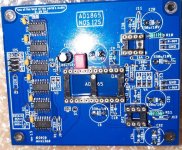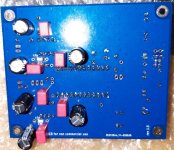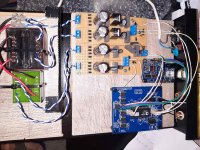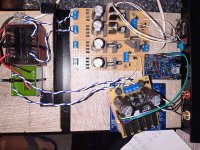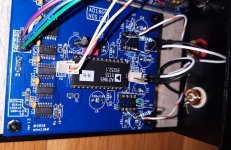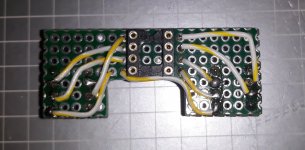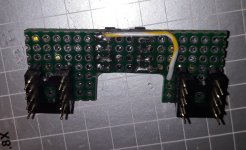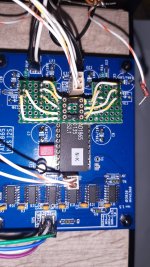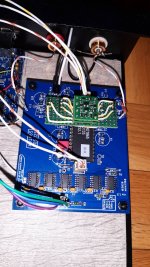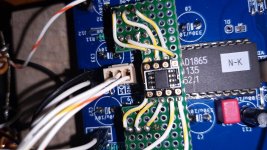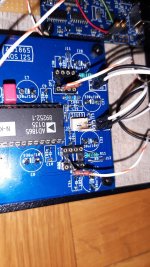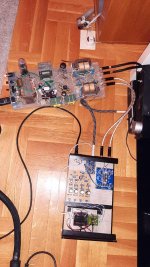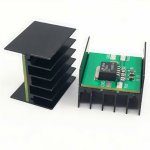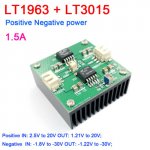Very useful information!The Japanese have this order and method in Yamaha devices with PCM63-P
On the signal path / Coupling: Nichicon Muse ES, Elna Silmic, Elna Cerafine, Elna Tonerex, Muse FG
Power supplies (Analog): Elna Tonerex, Nichicon Muse KZ, Panasonic FM or Nichicon UHE, Elna Silmic / Cerafine, Muse FG
Power supplies (Digital): Sanyo OS-Con, Panasonic FM, Nichicon Muse KZ
There is no end to this madness ... There is always something extra, some new expense 🤣
For PSU I choose Panasonic FC and Epcos caps (Nichicon KG is too expensive) and Dac board will be with Silmic 2. On this week I should got all caps and resistors. Because of sanctions on my country I buyed in two different shops and also at two different local vendors! It's just so bad))
Yes AHCT could be also OK?
Also DIP packages has bigger DIE and more "room" between the internal elements? That could decrease noise and other unwanted things in audio domain... Somehow I like it more additionally because we simply can pull out and replace IC?
.
"By 1986 surface mounted components accounted for 10% of the market at most, but was rapidly gaining popularity.[2] By the late 1990s, the great majority of high-tech electronic printed circuit assemblies were dominated by surface mount devices." From the WikiP, I didn't knew that it was like this...
A DIP package is unlikely to have a different die from the SMD equivalent. But DIP has a larger leadframe hence more inductance. The extra inductance gives more 'bounce' on the supply rails from switching and hence more noise on the outputs.
I would be interested to hear what logic family (apart from package, speed, propagation delay etc.) is best suited for digital audio: somewhere on this forum I read that LVC and AHCT are preferred, and F series sound bad (iirc) - but why? And what about AUP and NC7?
I doubt that there is a logic family which suits all digital audio use. It all depends how fast you need to go - I prefer the slowest logic that gets the job done. That's often 74HC which has the nice feature that its speed is tailored by its supply voltage.
A new a present has arrived at my door, but I'm still waiting on a few more parts before I begin. My plan is to build Miros original configuration. I'll be using a WaveIO with separate PSUs that I stole from an older project to feed the DAC. I won't populate the MSB trim components (R5,6,7, TR1,2) since I have no scope to do the trimming, and will also omit the RC filter (R10,11, C37,38). I have a few opamps to try in the board (NE5532, AD797, LME49710, LT1363, and some sparko labs single discrete opamps) If anyone sees any problems with using any of these opamps please let me know. I also have separate =/- 5v and 12v PSUs for the DAC. If I can get everything together and working without burning things up, I also have a spare JlSounds output stage that I might try to see if it makes any difference. I have a bunch of delta sigma DACs and a couple of NOS multibit DACs on hand that I can compare this one with. Now I just need to finish reading this thread so I have some idea of what I'm doing. I'm looking forward to a fun project.
Attachments
Cool, Enjoy your build!
If you plan on opamp rolling, populate the components around the DIP8 sockets underneath the board. You'll gain better access for swapping especially if using discrete opamps like Sparkos and Burson.

If you plan on opamp rolling, populate the components around the DIP8 sockets underneath the board. You'll gain better access for swapping especially if using discrete opamps like Sparkos and Burson.

@PJN ,
You will have fun for sure.
What you can do is not to solder the opas caps to compare what you have on hand playing with both 0.1 uF area and the bigger close cap. In relation to the amp, the rest of your hifi, some choice will please you better as you already know... you can play with the voltage ratting of the cao, its capacitance, the serie/brand...
The 0.1 uF Wima FKP2 in the bag are good one and give a warm smooth presentation with details yet, etc, etc
You will have fun for sure.
What you can do is not to solder the opas caps to compare what you have on hand playing with both 0.1 uF area and the bigger close cap. In relation to the amp, the rest of your hifi, some choice will please you better as you already know... you can play with the voltage ratting of the cao, its capacitance, the serie/brand...
The 0.1 uF Wima FKP2 in the bag are good one and give a warm smooth presentation with details yet, etc, etc
Attachments
Pavouk vs. Miro with AD1865 🤓Yes adapter from two single OP to double OP.
Picture no.3 - TL071 OP, no.4 - Pavouk version, no.5 - 330R I/V.
Since I know the adapter works, I can say that I made it. We don't have any single OPA except TL071, but we have a lot of these doubles, OPA2604AQ, LME49720, OPA1612, OPA1622, SS3602 and many others.
... I subjectivly prefered the 1655/56 to the 1611/12 when used in the Miro's standalone opa concept. However I would be curious to hear it with the 1611/12 as I/V followed by the 1656 or 1648 as buffer. but these wide band opas need care : short decoupling, stacking pcbs not recommended with them.
If someone has tried this combo I would be curious about how he liked it VS a 16555/1656 alone.
Has someone tried C31 & C36 traces to try a Sussumu RG thin film resistors as I/V in spite of the through hole resistor ?
If someone has tried this combo I would be curious about how he liked it VS a 16555/1656 alone.
Has someone tried C31 & C36 traces to try a Sussumu RG thin film resistors as I/V in spite of the through hole resistor ?
Last edited:
What is the result of the test?😬Since I know the adapter works, I can say that I made it. We don't have any single OPA except TL071, but we have a lot of these doubles, OPA2604AQ, LME49720, OPA1612, OPA1622, SS3602 and many others.
OPs? SS3602 of course.What is the result of the test?😬
Last edited:
Almost all OPs tried and of course Sparkos sounds the best, as expected. Then we listened only to the 1K resistor at the output and later we added 7n7 gain stage (i know 1k is too much but that resistor sounded significantly nicer than 300R and 560R ordinary resistors). I expected it to be the best with the resistor+tube because I had already heard that combination with the 6n6p. Zhanks @NIXIE62 for the adapter. Next PCM63.Since I know the adapter works, I can say that I made it. We don't have any single OPA except TL071, but we have a lot of these doubles, OPA2604AQ, LME49720, OPA1612, OPA1622, SS3602 and many others.
Just to add that the resistor greatly affects the sound quality. This is some randomly purchased 1k grid stopper resistor for some tube devices.
Attachments
Passive I/V plus tube gain stage (with phase reversal of course) is probably the best solution at least subjectively, and for compact devices SS3601 Sparkos or better discrete OPA if it exists for active I/V stage. And mandatory power supply of I/V stage to be done separately, +-10 to +-15VDC. That, of course, is my impression. The only thing that remains unresolved are the problems with finding LT1963/3015.
I ordered the finished modules LT1963/3015 from China, I hope they are not fake. For now, don't look suspicious. I will replace the ceramic capacitors for PP, see if there is anything to change, add some electrolytic capacitors and hope for the best.
I ordered the finished modules LT1963/3015 from China, I hope they are not fake. For now, don't look suspicious. I will replace the ceramic capacitors for PP, see if there is anything to change, add some electrolytic capacitors and hope for the best.
Attachments
Last edited:
I wonder how you will plug them into an existing PSU2 - PCB - some new adapter ?I ordered the finished modules LT1963/3015 from China, I hope they are not fake. For now, don't look suspicious. I will replace the ceramic capacitors for PP, see if there is anything to change, add some electrolytic capacitors and hope for the best.

No way, PSU2 boards are sitting and waiting for better times. I will make the rest of the circuit, grec and capacitors on a raster board
I am preparing very good discrete PSU ... it will easily replace the PSU2 🤓
- Home
- Source & Line
- Digital Line Level
- DAC AD1862: Almost THT, I2S input, NOS, R-2R
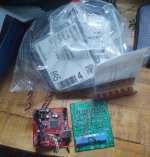
![20220627_233417[1].jpg](/community/data/attachments/975/975258-37844a2708c8845d810b10f19f4fc6b3.jpg?hash=N4RKJwjIhF)
![20220627_233346[1].jpg](/community/data/attachments/975/975262-362ffcfa1842018dd72c3fb2f3d4f364.jpg?hash=Ni_8-hhCAY)
